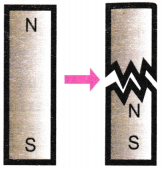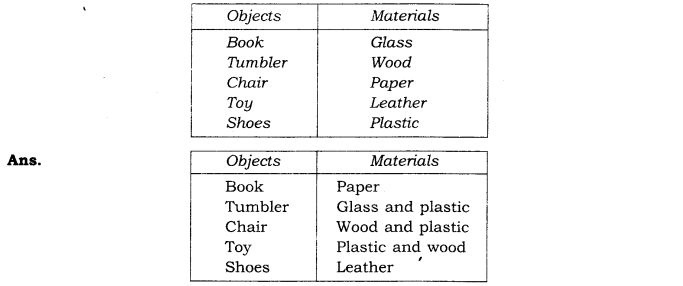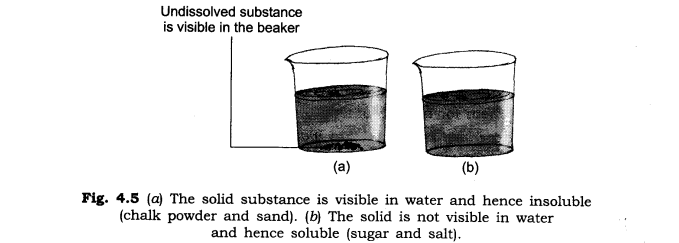Exploring Magnets NCERT Class 6th Science Chapter 4 Question Answer
Exploring Magnets Class 6 Questions and Answers
Question 1.
Bo magnets stick to objects made of certain materials only? (Page 62)
Answer:
Yes, magnet attracts certain materials whereas some do not get attracted towards magnet. The materials which get attracted towards a magnet are magnetic e.g. iron, nickel, cobalt etc. The materials which are not attracted towards a magnet are non-magnetic. In their natural states, metals such as aluminium, brass, copper, gold, lead and silver do not attract magnets.
Question 2.
Do all parts of a magnet attract magnetic materials equally? (Page 64)
Answer:
No, all parts of a magnet do not have equal magnetic strength. In a bar magnet, the magnetic field around the poles is stronger than the middle part, where the magnetic field is weaker. Also in case of horseshoe magnet, the magnetic strength is higher near the poles.

Question 3.
Can we find a magnet with a single pole? (Page 65)
Answer:
No, any magnet has always two poles namely north and south. We cannot make a magnet with only one pole.

Let us enhance our learning (pages 74-76)
Question 1.
Fill in the blanks
(i) Unlike poles of two magnets ______ each other, whereas like poles ______ each other.
(ii) The materials that are attracted towards a magnet are called ______.
(iii) The needle of a magnetic compass rests along the ______ direction.
(iv) A magnet always has ______ poles.
Answer:
(i) attract, repel
(ii) magnetic materials
(iii) north-south
(iv) two
![]()
Question 2.
State whether the following statements are True (T) or False (F).
(i) A magnet can be broken into pieces to obtain a single pole.
Answer:
False
(ii) Similar poles of a magnet repel each other.
Answer:
True
(iii) Iron fiings mostly stick in the middle of a bar magnet when it is brought near them.
Answer:
False
(iv) A freely suspended bar magnet always aligns with the north-south direction.
Answer:
True
Question 3.
Column I shows different positions in which one pole of a magnet is placed near that of the other. Column II indicates the resulting action between them for each situation. Fill in the blanks.

Answer:

Question 4.
Atharv performed an experiment in which he took a bar magnet and rolled it over a heap of steel U-clips

Bar magnet and heap of steel U-clips
According to you, which of the options given in Table is likely to be his observation?
Table: Number of pins attracted by the magnet at its various positions

Answer:
From the figure, it is clear that the ends of the magnet have more iron fillings attached to it. This is because the strength of a magnet lies more at the ends of the magnet. Hence option (i) is correct.
Question 5.
Reshma bought three identical metal bars from the market. Out of these bars, two were magnets and one was just a piece of iron. How will she identify which two amongst the three could be magnets (without using any other material)?
Answer:
Magnets both attract and repel, whereas iron only attracts. Thus, repulsion helps to find which one is the bar and which one is the magnet.
Question 6.
You are given a magnet which does not have the poles marked. How can you find its poles with the help of another magnet which has its poles marked?
Answer:
To find the poles of an unmarked magnet, bring one end of the marked magnet near one end of the unmarked magnet. If they attract, the unmarked magnet’s end is the opposite pole (i.e., if the marked North pole attracts, then the unmarked end is South pole). If they repel, then the poles are similar.
Question 7.
A bar magnet has no markings to indicate its poles. How would you find out near which end its North pole is located without using another?
Answer:
When a bar magnet is suspended freely, it always rests in north-south directions. The end pointing towards north is called north seeking end or the north-pole and the end pointing towards south is called south seeking end or the south-pole of the magnet.
![]()
Question 8.
If the earth is itself a magnet, can you guess the poles of earth’s magnet by looking at the direction of the magnetic compass?
Answer:
Yes, we can guess the poles of Earth’s magnet by looking at the direction of the magnetic compass. The north seeking end of the compass needle points towards the geographic North Pole of the Earth.
Question 9.
While a mechanic was repairing a gadget using a screw driver, the steel screws kept falling down. Suggest a way to solve the problem of the mechanic on the basis of what you ‘have learnt in this chapter.
Answer:
The mechanic needs to magnetise his screwdriver which will not just lift the screw but hold it in place while he works.
To magnetise a screwdriver he needs a magnet. He be advised to, “place the screwdriver on a wooden table. Then keep one end (pole) of the magnet at one end of the metallic part of the screwdriver. Move the magnet along the length of the metallic part of screwdriver. Lift it and bring the same pole of magnet to the same end of screwdriver he began, and repeat moving it over the length of the screwdriver. On repeating this process about 30 times the screwdriver will get magnetised”
Question 10.
Two ring magnets X and Y are arranged as shown in Fig. (below). It is observed that the magnet X does not move down further. What could be the possible reason? Suggest a way to bring the magnet X in contact with magnet Y, without pushing either of the magnets.

Two ring magnets
Answer:
Magnet X must be floating because the like poles are facing each other (like poles repel each other). If we change the direction of the magnet X by rotating it the unlike poles will face each other and the magnets will come closer.
Question 11.
Three magnets are arranged on a table in the form of the shape shown in Fig. (below). What is the polarity, Nor S, at the ends 1, 2, 3, 4 and 6 of the magnets? Polarity of one end (5) is given for you.

Three bar magnets
Answer:

| Point | Polarity |
| 1 | N |
| 2 | S |
| 3 | N |
| 4 | S |
| 6 | S |
Activities
Activity 4.1 (Page 62)
- Collect a few objects made of different materials and also a magnet.
- Predict which of the objects will stick to the magnet. Write your prediction in Table 4.1.
- Now hold a magnet in your hand and bring it near the objects one by one

Observe which of the objects stick to the magnet.
Record your observations in Table 4.1.

Answer:
Table 4.1: Identifying the materials attracted by a magnet

NCERT Solutions for Class 6 Science Chapter 4 Sorting Materials Into Groups
Topics and Sub Topics in Class 6 Science Chapter 4 Sorting Materials Into Groups:
| Section Name | Topic Name |
| 4 | Sorting materials into groups |
| 4.1 | Objects around us |
| 4.2 | Properties of materials |
Q. 1. Name five objects which can be made from wood.
Ans.
(i) Table
(ii) Chair
(iii) Doors
(iv) Boat
(v) Bed
Q.2. Select those objects from the following which shine:
Glass bowl, plastic toy, steel spoon, cotton shirt
Ans. Glass bowl and steel spoon are shining objects.
Q.3. Match the objects given below with the materials from which they could be made. Remember, an object could be made from more than one material and a given material could be used for making many objects.

Q. 4. State whether the statements given below are ‘true’ or ‘false’.
(i) Stone is transparent, while glass is opaque.
(ii) A notebook has lustre while eraser does not
(iii) Chalk dissolves in water.
(iv) A piece of wood floats on water.
(v) Sugar does not dissolve in water.
(vi) Oil mixes with water.
(vii) Sand settles down in water.
(viii) Vinegar dissolves in water.
Ans.
(i) False
(ii) False
(iii) False
(iv) True
(v) False
(vi) False
(vii) True
(viii) True
Q. 5. Given below are the names of some objects and materials:
Water, basket ball, orange, sugar, globe, apple and earthen pitcher Group them as:
(a) Round shaped and other shapes
(b) Eatables and non-eatables
Ans.
(a) (i) Round shaped: Basket ball, apple, orange, globe, earthen pitcher.
(ii) Other shapes: Water, sugar.
(b) (i) Eatables: Water, orange, sugar and apple.
(ii) Non-eatables: Basket ball, globe and earthen pitcher.
Q. 6. List all the items known to you that float on water. Check and see if they will float on an oil or kerosene.
Ans. (A) List of some items that float on water:
- Paper
- Wood
- Thin plastic sheets
- Wax
- Ice
- Thermocol
- Oil
(B) List of items that float on an oil:
- Paper
- Plastic sheet
- Wax
- Thermocol
- Wood
(C) List of items that float on kerosene:
- Paper
- Thermocol
- Thin plastic sheet
Q. 7. Find the odd one out from the following:
(a) Chair, Bed, Table, Baby, Cupboard
(b) Rose, Jasmine, Boat, Marigold, Lotus
(c) Aluminium, Iron, Copper, Silver, Sand
(d) Sugar, Salt, Sand, Copper sulphate
Ans.
(a) Baby (all others are non-living)
(b) Boat (all others are flowers)
(c) Sand (all others are metals)
(d) Sand (all others are soluble in water)
Class 6 Science Chapter 4 VERY SHORT ANSWER TYPE QUESTIONS
1. Why do we need to group materials? Give one reason.
Ans: We often group materials for our convenience. It helps to describe their properties.
2. Suggest two bases on which we can group objects.
Ans:
(i) Material used in making the object, e.g. wood or metal/plastic.
(ii) Material of the object is soft or hard, or substance is soluble or insoluble in water.
3. Is a substance which can be compressed soft or hard?
Ans: Soft.
4. Select a lustrous material out of the following substances:
Ans: Aluminium.
5. Which material is generally used for making pens?Wood, aluminium, plastic, cotton
Ans:Plastic or metal.
6. Is oil soluble in water?
Ans: Oil does not dissolve in water so it is insoluble in water but floats on the surface of water.
7. Name two objects which are made from opaque materials.
Ans: Wooden doors, blackboard/steel plate.
8. What is common between salt and sand?
Ans: Both have mass and are in solid state.
9. List three liquids which are transparent.
Ans. Water, alcohol and Acetone/Benzene.
10. Write two substances which are made from leather.
Ans: Belt and shoes.
11. Name some substances which are made from plastics.
Ans: Toys, plates, cups, buckets, baskets.
12. Which is more hard, sponge or iron?
Ans: Iron is harder than sponge.
13. Write two gases which are soluble in water.
Ans: Oxygen, Carbon dioxide.
14. Name two gases which are insoluble in water.
Ans: Hydrogen and Nitrogen.
Class 6 Science Chapter 4 SHORT ANSWER TYPE QUESTIONS
1. Write any four properties of materials.
Ans:
(a) Appearance
(b) Hardness
(c) Solubility
(d) Float or sink in water
(e) Transparency
2. Why is a tumbler not made with a piece of cloth?
Ans: We use tumblers made of glass, plastic and metal to keep a liquid. These substances can hold a liquid.
A tumbler made of cloth cannot hold a liquid because:
(i) Cloth piece is not hard enough to hold liquids and
(ii) Cloth piece has very minute pores through which the’liquid oozes out.
3. What are the similarities between iron, copper and aluminium?
Ans:
(a) They all have lustre,
(b) They are all metals,
(c) They are hard.
4. Mention some materials which are made up of paper.
Ans: Books, notebooks, newspapers, toys, calendars, etc.
5. Why is water important for our body?
Ans: Water can dissolve a large number of substances, so it is needed by the body. It is also major part of our body cells.
6. What is the basis for sorting materials?
Ans: Materials are grouped on the basis of similarities or dissimilarities in their properties.
7. What is the reason for grouping materials?
Ans: Materials are grouped for our convenience to study their properties and also observe any patterns in these properties.

9. Make a table of different types of objects that are made from the same material.

10. Make a table and find out whether the following materials mix with water: Vinegar, Lemon juice, Mustard oil, Coconut oil, Kerosene.

11. Metals have lustre (shine). Give reason why some metal articles become dull and loose their shine.
Ans: Metals when exposed to air react with moisture and gases present in it, thereby forming a dull layer of some other compound on it.
12. Kerosene, coconut oil, mustard oil do not dissolve in water, even on shaking. They separate after sometime forming two different layer. Explain why.
Ans: The molecules of water do not intermingle (mix) with the molecules of oil. The space between the molecules of water is not taken by oil, so they are immiscible in water.
13. Name a non-metal that has lustre.
Ans: Iodine.
14. Metals generally occur in solid state and are hard. Name a metal that exists in liquid state and a metal that is soft and can be cut with knife.
Ans: Mercury is a metal that exists in liquid state. Sodium and Potassium are soft metals and can be cut with knife.
15. Name the naturally occuring hardest substance known.
Ans: Diamond, it is made up of carbon (non-metal).
16. Why is water called a universal solvent?
Ans: Water dissolves a large number of substances in it. So it is called universal solvent.
Class 6 Science Chapter 4 LONG ANSWER TYPE QUESTIONS
1. ‘Grouping of objects helps the shopkeeper.’ Justify the statement.
Ans: Proper grouping of objects helps shopkeeper in the following ways:
(i) He can locate the required object easily and quickly.
(ii) He can easily come to know what stocks are going to finish and he should purchase them for his customers.
2. Describe an experiment to prove that water is transparent.
Ans: Take a beaker half-filled with clean water. Put a coin in beaker of water.
Place the beaker undisturbed for a few minutes where enough light is present. Now, observe the coin immersed in water from the top of the beaker. Are you able to see the coin? You can clearly see the coin immersed in water. This proves that water is a transparent liquid.

3. Write an experiment to show that our palm is translucent.
Ans: Cover the glass of a torch with your palm at a dark place. Switch on the torch and observe from the other side of palm. We see that the light of torch passes through palm but not clearly. This experiment shows that our palm becomes translucent when a strong beam of light passes through it.

4. How can you show that some solids like sugar, salt are soluble in water whereas solids like chalk powder and sand are not soluble in water?
Ans: Collect samples of sugar, salt, chalk powder and sand. Take four beakers. Fill each one of them about two-third with water. Add a teaspoonful of sugar to the first beaker, salt to the second, chalk powder to the third and sand to the fourth. Stir the contents of each beaker with a spoon/stirrer.

Wait for a few minutes and observe what happens to the substances added to the’ water.
Note down your observations in the following table.

Inference:
(i) Sugar and salt are soluble in water.
(ii) Chalk powder and sand are insoluble in water.
NCERT Solutions for Class 6 Science – All Chapters
- Chapter 1 The Wonderful World of Science
- Chapter 2 Diversity in the Living World
- Chapter 3 Mindful Eating: A Path to a Healthy Body
- Chapter 4 Exploring Magnets
- Chapter 5 Measurement of Length and Motion
- Chapter 6 Materials Around Us
- Chapter 7 Temperature and its Measurement
- Chapter 8 A Journey through States of Water
- Chapter 9 Methods of Separation in Everyday Life
- Chapter 10 Living Creatures: Exploring their Characteristics
- Chapter 11 Nature’s Treasures
- Chapter 12 Beyond Earth